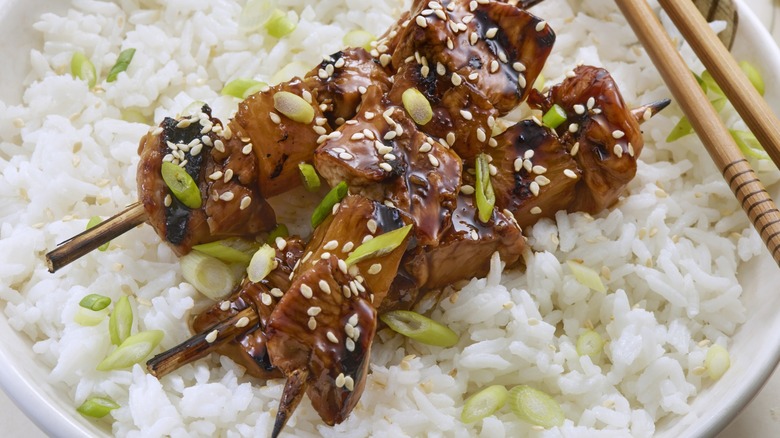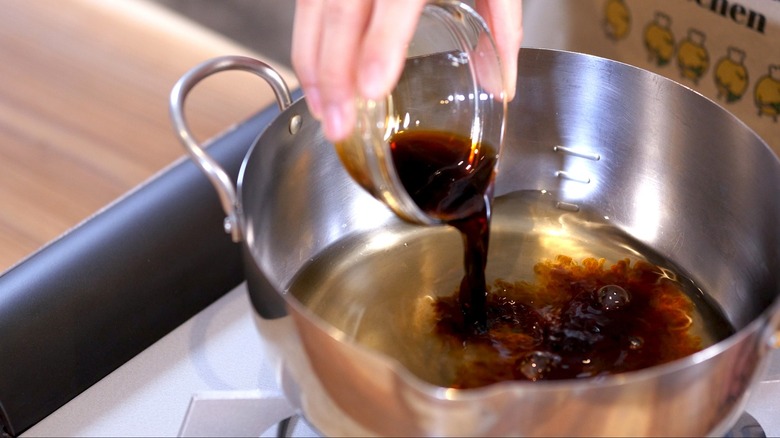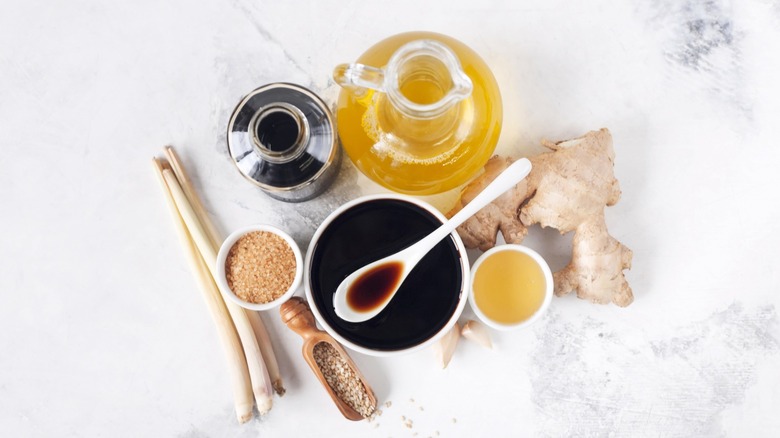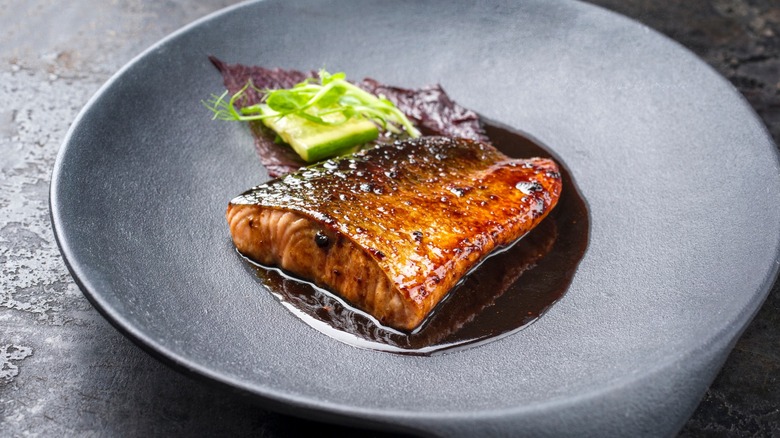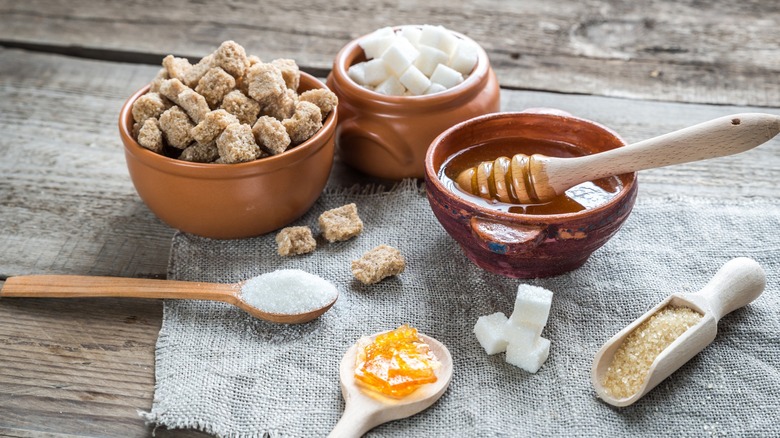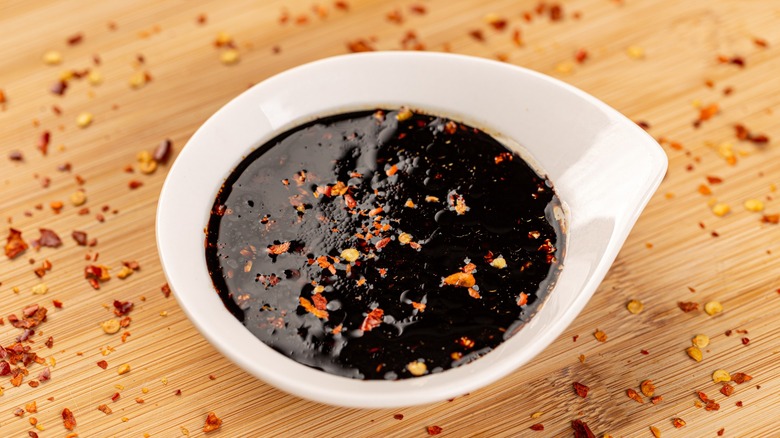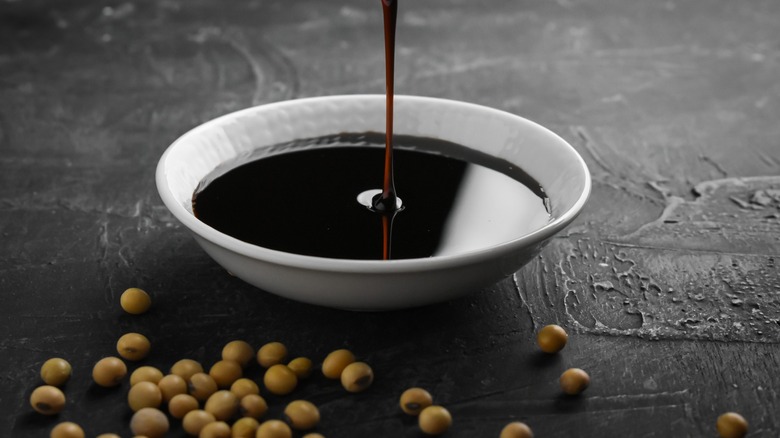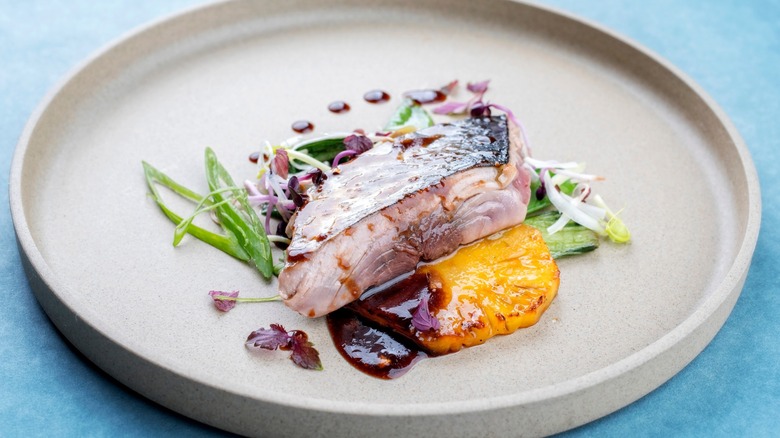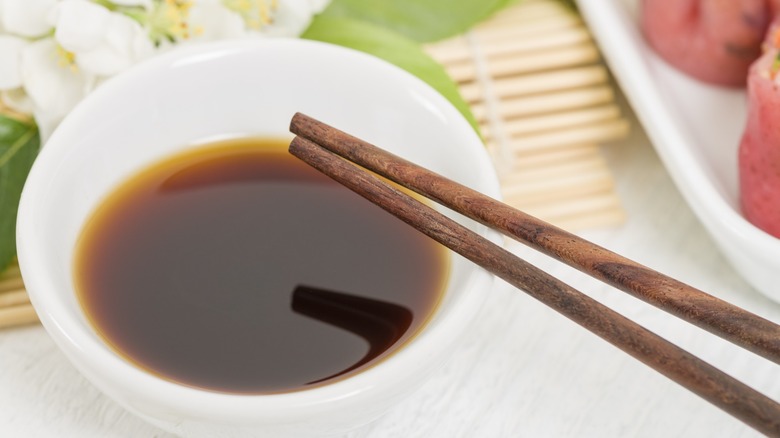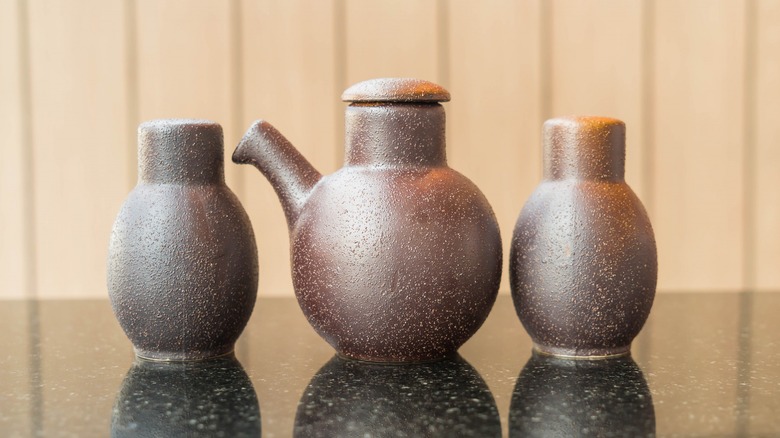11 Tips For Making The Best Teriyaki Sauce
There's an important distinction to be made when talking about teriyaki and teriyaki sauce. In Japan, teriyaki is a dish that encompasses quite a few things. Yaki means grill, and the word teri is simply the Japanese word for shine. Teriyaki is the cooking technique that bastes proteins on the grill with a sweet, soy-based sauce. The sugar caramelizes, giving the meat a shiny finish common to all teriyaki-style foods. It's also traditionally made with three of Japan's favorite ingredients and little else. Soy sauce, mirin, and sake make up the majority of the sauce, while a little sugar might also be added. A pinch of an aromatic like ginger or garlic or the occasional chili isn't frowned upon, either.
Here, we equate teriyaki with the sauce we use in multiple ways, dipping and drizzling our way through loads of sweet-salty goodness. It's easy enough to make, so why not start trying it at home? That way, you can customize it to your liking and make as much as you want. My preference is the more traditional version that I've learned to make working in a Japanese kitchen, mainly for the simplicity, ease of preparation, and the fact that I can add as much shichimi togarashi (Japanese seven spice) as I want. I do have a favorite store-bought brand, but after making loads of sauce myself, I realized just how salty the pre-made stuff is. If you're a fan of Japanese flavors and have a few basic ingredients on hand, I suggest you give it a go.
Start with a traditional version
Since teriyaki in Japan refers to a style of dish rather than a specific food, the sauce itself isn't really found in grocery stores. Rather, it's made as part of each different recipe. However, the same three or four ingredients are generally used — soy sauce, mirin, sake, and sometimes sugar, depending on how much sweetness you want. Keep in mind that mirin is a sweetened rice wine, and that will contribute to the stickiness and sought-after shine in the finished product.
Once you have those basic ingredients, you're on your way to making a terrific homemade teriyaki sauce. It doesn't take much more than simmering the ingredients until the sauce thickens and you're done. A formula for the amounts needed is simple – 2 tablespoons each of mirin, soy, and sake, to 1 tablespoon of sugar. This ratio makes it easy to scale up the amount, too. Add ingredients to an appropriately sized saucepan and gently simmer until thickened to your liking. Keep in mind that the sauce will thicken as it cools, too.
Try adding a few other ingredients to customize it
We suggest that you try the basic method at least once, just to get a taste of the traditional recipe. But after that, you can start adding nearly anything that tickles you. The most common additions are ginger, garlic, sesame seeds, or chili. While traditional Japanese cooking relies on a delicate balance of flavors, sometimes you just want a little more boldness on your plate. If that's the case, feel free to amp up your sauce as you go.
One of our key spice blends for bold teriyaki sauce is still Japanese, so you can rest assured that it plays well with the other ingredients (you didn't think we were going to say Everything Bagel, did you?). If you're not familiar with shichimi togarashi, you're in for a delightful surprise. The spice mixture, also known as Japanese Seven Spice, is a perfectly balanced mixture of heat, citrus, and smokiness, made with citrus peel, sesame seeds, ginger, ground peppers, and nori. Other ingredients, such as poppy seeds, Sichuan peppercorns, or shiso can be used as well, so read the label ingredients to find a blend you'll prefer.
Decide how you're going to use it before you begin
Depending on how you'll be using your teriyaki sauce, you might need to make some adjustments to whatever recipe you choose. And don't kid yourself; there are dozens of ways to use this sweet and salty condiment, from marinade to finishing sauce and everywhere in between. In Japan, teriyaki sauce is the basis for several fish dishes, using fattier cuts in particular. The ingredients work exceptionally well with seafood like tuna, yellowtail, and eel, especially when grilled to bring out the crispy skin of the fish and the luster of the sticky glaze.
Over here, we tend to use teriyaki sauce in all sorts of different ways, including basting meat, but more often than not, we use it for dipping and drizzling over finished dishes. Dumplings, potstickers, chicken wings, and bowls of plain rice are all suitable foods for being doused in the brown stuff. You'll want to let your sauce thicken up quite a bit if you're going to use it as a sauce, whereas the marinating version will work better if it has a more liquid body that can get into all the nooks of your protein.
Understand how to substitute ingredients
Most old-school Japanese recipes don't suggest substituting honey for sugar in teriyaki because of the stronger flavor, but it is an ingredient you'll often see in more Westernized versions. If you prefer honey or even maple syrup and don't mind the flavor, then you can go ahead and squeeze some in. Substituting cane sugar for white won't make much of a difference, although dark brown sugar will add a subtle touch of molasses to your finished product.
When it comes to soy sauce, sake, and mirin, however, you might need to do a little research beforehand. There are hundreds of soy sauces out there — for the most part, you'll want to go with a Japanese version to begin. If you're gluten-free, try tamari instead (just read the label to be certain). As for mirin, two ingredients will make a decent substitute. Mirin is essentially sake with a higher sugar content, so you can feel confident mixing those ingredients into a pretty decent replacement. Our suggestion is two parts sake to one part sugar, two items you might already be using anyway. It also works in the opposite way if you have mirin but no sake; use mirin but reduce the overall sweetener in the sauce by one-third.
Using a simple recipe still gives a great result
As we've already mentioned, teriyaki sauce is a simple recipe that can be used to elevate any number of dishes. It's perfect when you want a little pop of umami and some delicious flavor in a flash. If you're not convinced how truly easy it is to make, trust us — even the simplest version is super tasty, and adding your own spin is a cinch, too. Our at-home teriyaki sauce recipe is a great place to start and should help convince you to make it a mainstay in your meal rotation.
One of the best reasons to make sauce at home, besides saving money if you've already got the components on hand, is that you can tailor it to your preferences. Sub in a low-sodium soy sauce or reduce the amount of sugar if those are concerns for you. Cooking for kids? Maybe a ton of spicy shichimi togarashi or Sichuan peppercorns isn't the way to go. Keep the recipe simple if you're pairing it with a simple dish, or amp up the ingredients to stand up to a flavorful beef and green pepper version.
Use high quality ingredients when you can
We've already mentioned the staggering amount of soy sauce available, including a sweet Indonesian version, a dark Chinese style, to Thailand's thick and syrupy version. In Japan, shoyu is the blanket version for most of the fermented soy-based sauces you'll find, and it's made from relatively few ingredients, just fermented soybeans, wheat, salt, and water. Using a higher-quality soy sauce ensures that you'll end up with a superior finished product, and if you're curious about what we think, we've already ranked 16 popular soy sauces just for you.
Depending on the Asian markets near you, you might have a harder time finding mirin or sake. In a smaller town, you might be tempted to purchase whatever you can find because it's the only one available. If you're desperate for a chicken teriyaki bowl right away, that might be your best bet. If you decide to get into the teriyaki lifestyle for good, you might need to branch out to online retailers to search for some better options. As far as sake is concerned, you do have the option of using drinking sake if you can't find the cooking version. But keep these two things in mind — first, cooking sake has salt added, so you might need to adjust for taste. Even more important, drinking sake is often far too expensive or delicious to be pouring into your dinner. However, it degrades within a few days of opening, so cooking with it is a great way to use up a week-old bottle.
Get to know some other versions
Teriyaki can be served in almost any way you'd like, from dipping your favorite dumplings into a bowl of it or slathering it all over a fried chicken sandwich. But if you'd like to expand your horizons even further, take a look at two other, more famous, versions. Japanese immigrants who ended up in Hawaii had to alter some of their favorite recipes when some ingredients proved hard to find in their new home. Sake and mirin weren't part of the Hawaiian diet, so the pineapple version of teriyaki was born. Using the enzyme-rich pineapple juice helped to tenderize whatever meat was on hand, and combined with brown sugar, soy sauce, garlic, and ginger, a popular new dish was introduced. The 1960s craze for everything Polynesian helped to introduce teriyaki and pineapples to the rest of North America, and it's stuck with us ever since.
And that brings us to the other well-known version, Seattle-style teriyaki. Brought to Seattle in 1976 by a Japanese immigrant, Toshi Kasahara, who introduced it to the city, teriyaki went through a second wave of adoration when John Chung moved to the city in 1983. From Korea, Chung introduced a quick-cooked version, unlike Kasahara's slow-cooked one, that was served in a sandwich instead of a bed of rice. Chung went on to train many other Korean immigrants, who still own numerous shops in Seattle and continue to dish up the beloved Seattle-style sando.
Know how to make store-bought sauce better
More often than not, you'll likely find that store-bought sauce has far more ingredients than what you'll make at home, including preservatives and loads more sugar and salt than you might like. However, if it's what you've got on hand, you still have some options to give it more oomph. This first step might be obvious, but just in case it's not — taste it first. Before you roll your eyes, we mean really taste it. Is it bland, too sweet, too salty? Almost anything can be balanced out or fixed, with the exception of a bad aftertaste. Fish sauce, Worcestershire, a squirt of hot sauce, or even a little extra mirin should help to liven things up.
One of our secrets to making incredible sauces is to know just how important a splash of acid can be. A dribble of rice vinegar in a bottled sauce can cut through richness, add brightness to something a little flat, or even downplay too much sweetness or saltiness. We suggest rice vinegar because it works with the palate of Japanese flavors you already have going on, but apple cider vinegar or even a little lemon juice will work in a pinch. If you're dealing with either sweet or salty, remember that they balance each other pretty well. Just go slowly to avoid making things worse.
Understand how to adjust the thickness of your sauce
Depending on how you plan to use your sauce, you must decide on the desired thickness. Teriyaki sauce vs. marinade comes down to how and when you use it. A thinner sauce works well for anything that involves marinating or a long cooking time. The amount of sugar in most sauces means that when cooked down too far, it will burn and blacken very quickly, so you want to use something that has a lot of liquid to go around. Dipping, on the other hand, calls for something thick and clingy that will add lots of flavor in a small dollop. And if you're lifting a chicken teriyaki sushi handroll to your mouth, you don't want that super thin liquid running all down your arm.
Many Westernized recipes call for corn (or potato) starch to thicken the sauce, but you don't need a thickener. Adding a starch is cheating yourself out of the depth of flavor you'll get when the ingredients simmer down and caramelize. Cornstarch also clouds the sauce and gets rid of that gorgeous, glossy finish teriyaki is known for. While that might not be important to you, the flavor should be. You'll be damping down the true taste of the sauce by not patiently letting the heat do its thing. If you go overboard and find the sauce is too thick (but not burned), gently loosen it up by adding a little of the wet ingredients, bit by bit, until you achieve the consistency you desire.
Experiment with using it in different ways, like making teriyaki jerky
Once you've mastered your teriyaki sauce, it's time to get ready to eat. What are you going to do with that glistening, brown goodness? Obviously, a few things come to mind, like glazing some salmon and chicken wings or whipping up your own version of the Seattle teriyaki sandwich at home. But there are all sorts of other things you could be doing. How about this homemade teriyaki beef jerky? It also makes a terrific marinade for tofu or a dipping sauce for certain kinds of sushi.
One particularly overlooked segment of teriyaki-based recipes, however, is the teriyaki cocktail. It's true, imbibers. There aren't many, and we have to admit that we haven't tried any ourselves, but don't let it stop the more adventurous out there. The Teriyaki Tuaci is made with a vanilla citrus liqueur, a dash of soy sauce, and a ginger garnish. It's served in a chilled shot glass, so if it's not that great, at least it's over quickly. The Bloody Mariyaki is pretty much what you'd expect; it's basically just a Bloody Mary with the addition of two dashes of teriyaki sauce. This one actually sounds pretty good because the cocktail already has a nice savory base that the teriyaki umaminess will perk up.
Know how to store your sauce so it lasts
Finally, you've made your own sauce and have experimented with all the possible things you can do with it. How do you keep it fresh so that you can do it all over again? This is especially important if you've gone all out and whipped up a huge batch so you'll always have enough on hand. While all the separate ingredients are perfectly fine left at room temperature, we would caution you to store your sauce in the fridge. Any clean jar or sauce bottle will work; just ensure it closes properly so the goodness inside doesn't absorb any offputting fridge aromas. It should stay good for about two weeks.
Another way to keep that sauce on hand is to freeze it. Teriyaki sauce freezes really well and will last even longer up to three months. Depending on the amount you've made, you can either freeze it in sandwich bags lying flat or by filling an ice cube tray with blobs of that sweet sauce. Once frozen, pop the cubes out and store them in a plastic bag in the freezer, using them as needed. This way, you'll be ready to add a quick boost to whatever you eat anytime.
